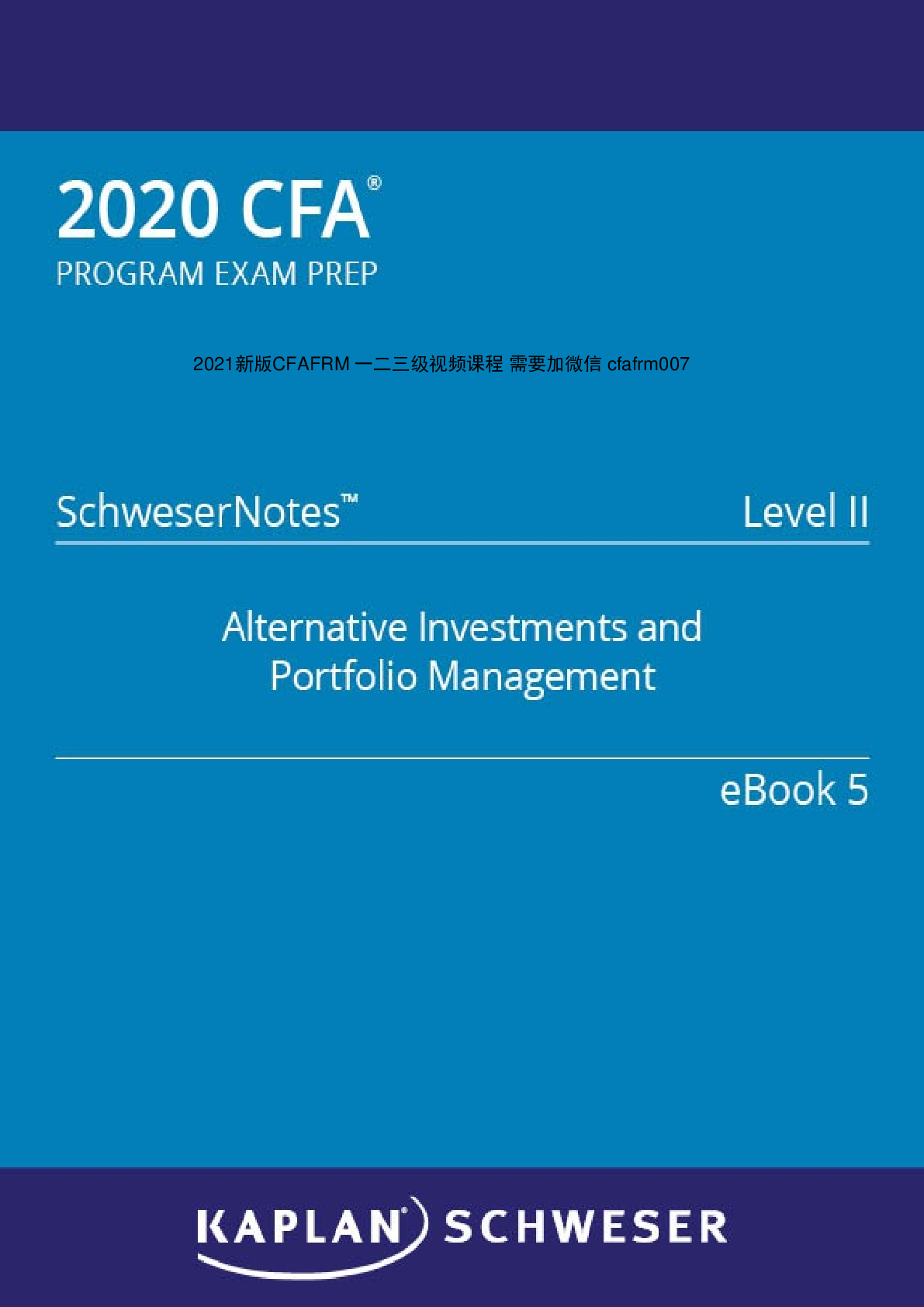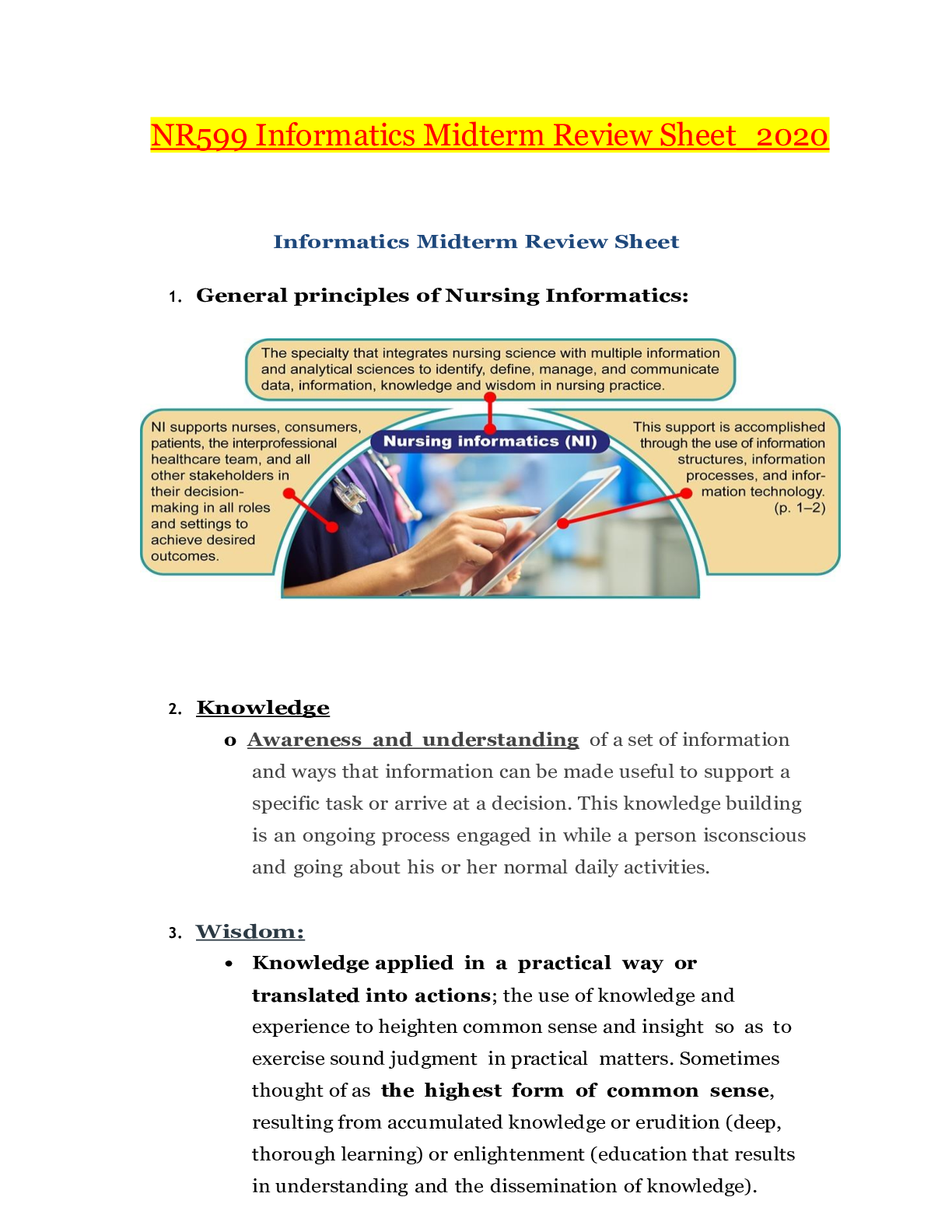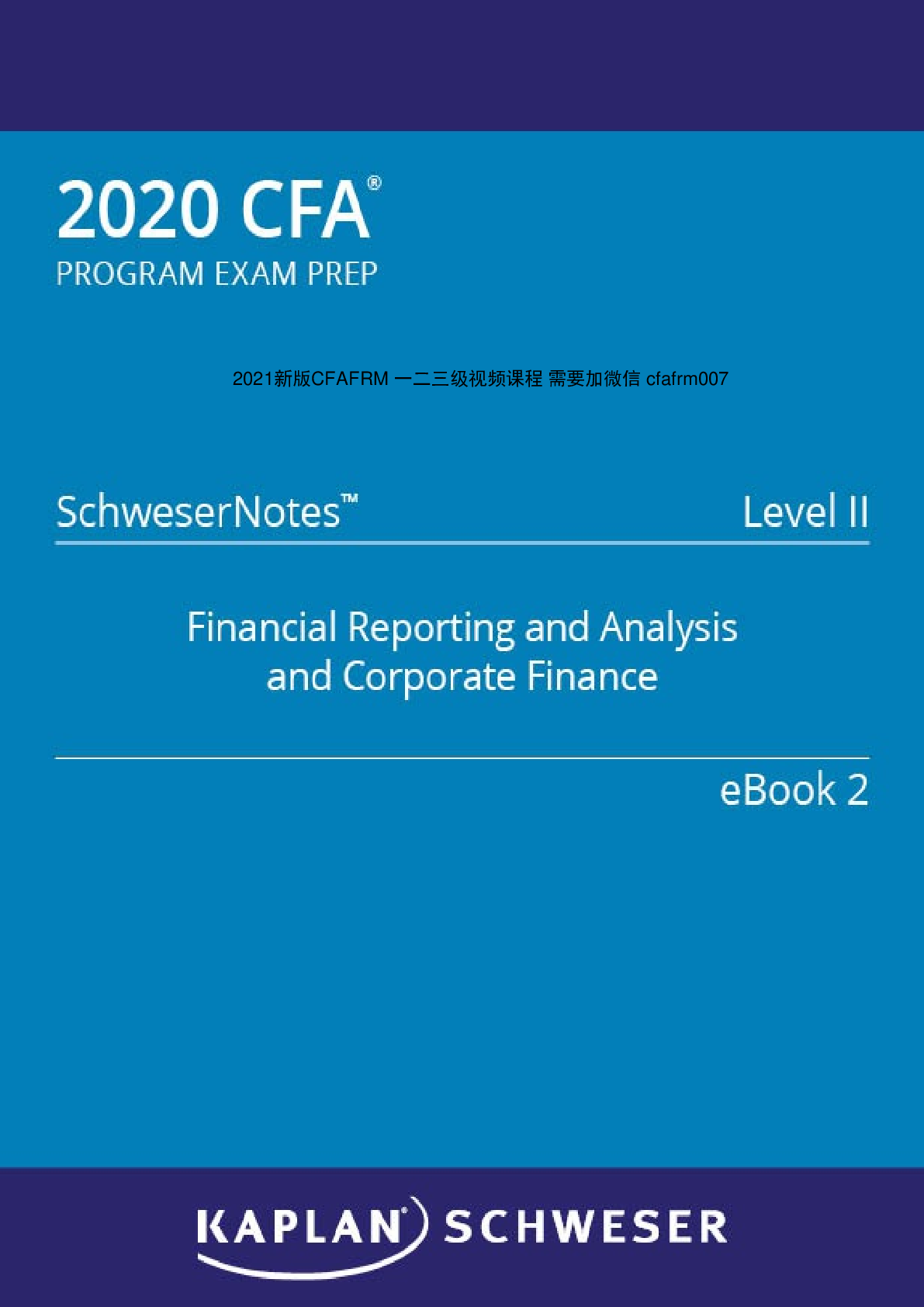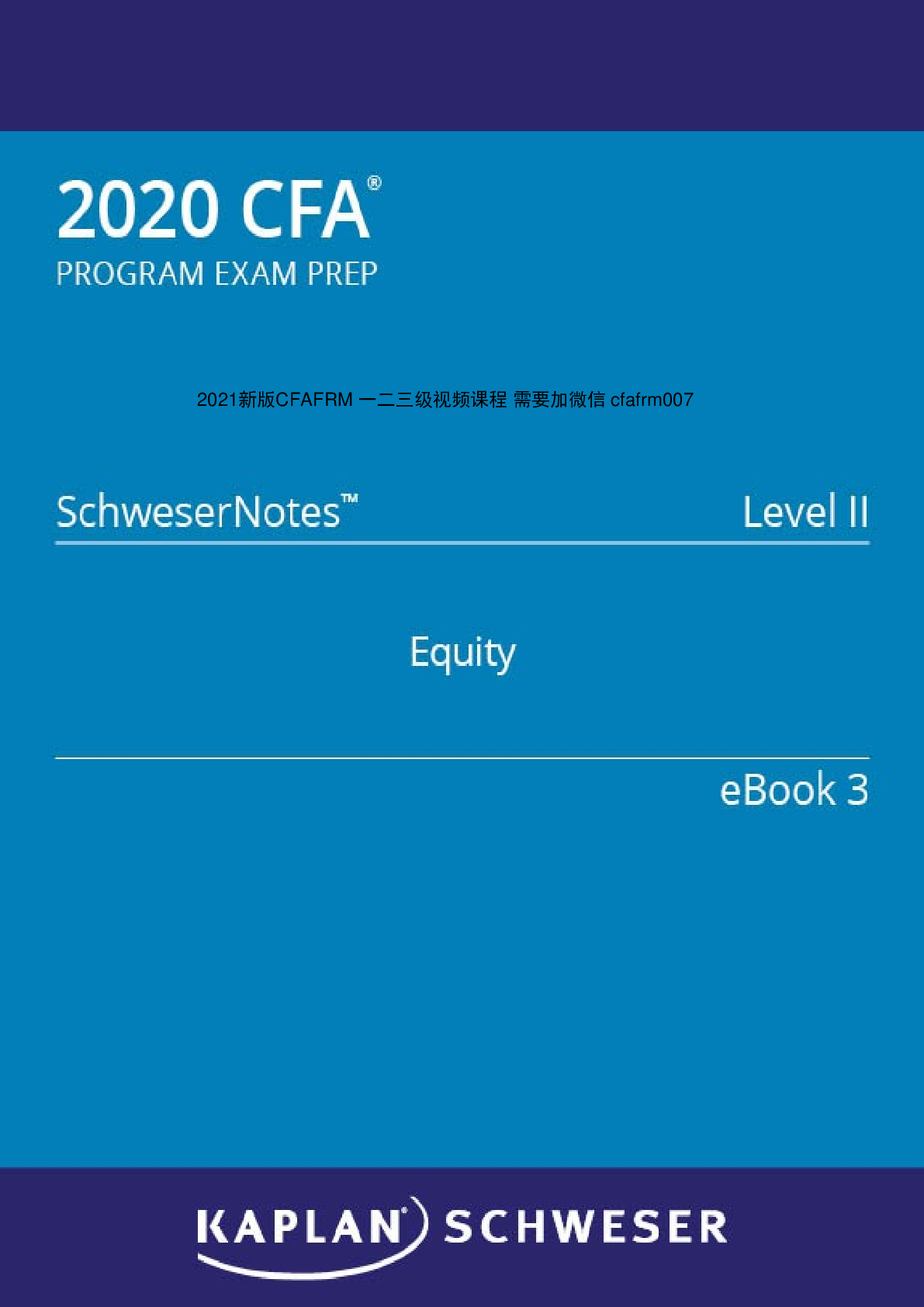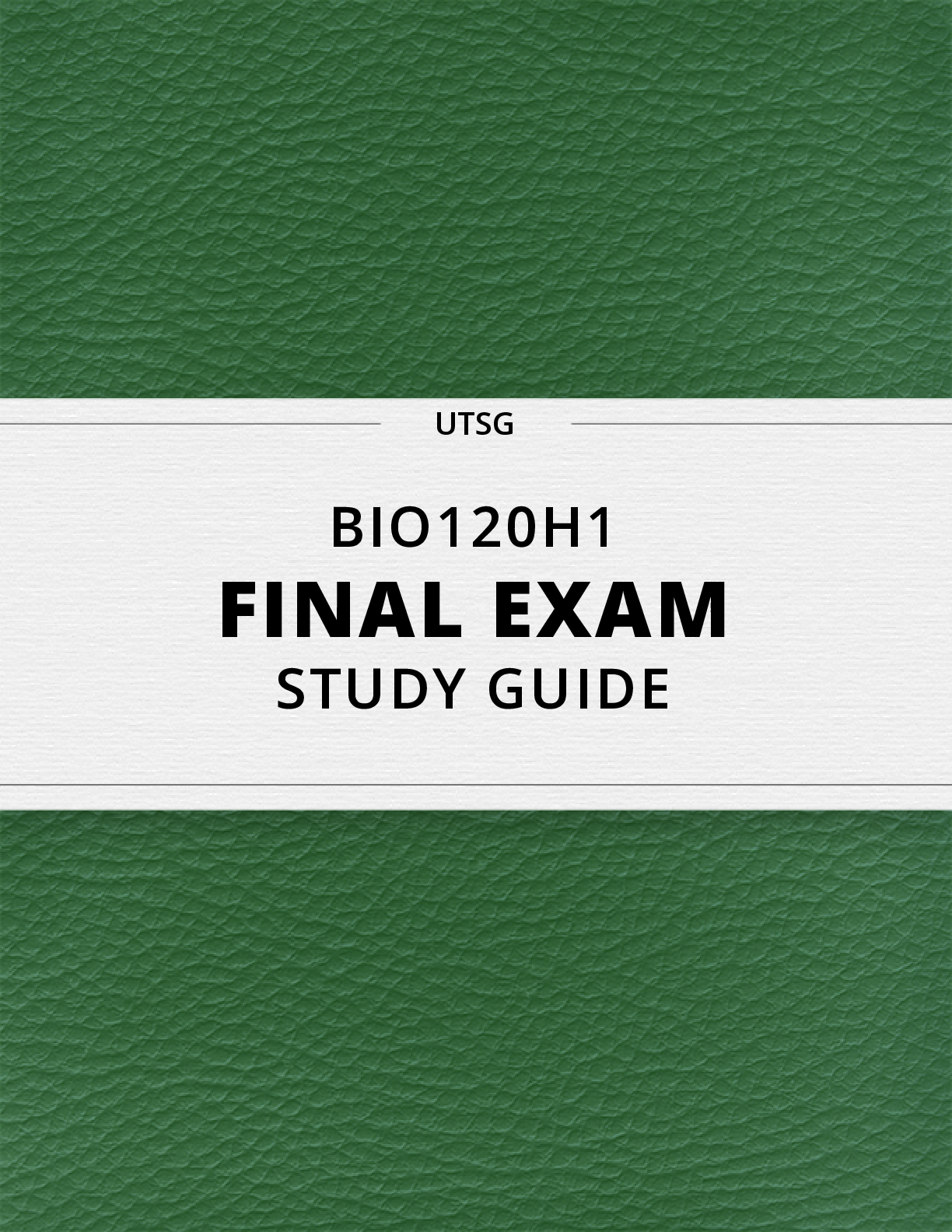Finance > Study Notes > Finance 11 _ SchweserNotes_Book_4_2_114_2020 CFA Program Exam Preparation | Fixed income Derivatives (All)
Finance 11 _ SchweserNotes_Book_4_2_114_2020 CFA Program Exam Preparation | Fixed income Derivatives
Document Content and Description Below
STUDY SESSION 12 The topical coverage corresponds with the following CFA Institute assigned reading: 32. The Term Structure and Interest Rate Dynamics The candidate should be able to: a. describe ... relationships among spot rates, forward rates, yield to maturity, expected and realized returns on bonds, and the shape of the yield curve. (page 2) b. describe the forward pricing and forward rate models and calculate forward and spot prices and rates using those models. (page 4) c. describe how zero-coupon rates (spot rates) may be obtained from the par curve by bootstrapping. (page 5) d. describe the assumptions concerning the evolution of spot rates in relation to forward rates implicit in active bond portfolio management. (page 7) e. describe the strategy of riding the yield curve. (page 10) f. explain the swap rate curve and why and how market participants use it in valuation. (page 12) g. calculate and interpret the swap spread for a given maturity. (page 14) h. describe the Z-spread. (page 15) i. describe the TED and Libor–OIS spreads. (page 16) j. explain traditional theories of the term structure of interest rates and describe the implications of each theory for forward rates and the shape of the yield curve. (page 17) k. describe modern term structure models and how they are used. (page 20) l. explain how a bond’s exposure to each of the factors driving the yield curve can be measured and how these exposures can be used to manage yield curve risks. (page 22) m. explain the maturity structure of yield volatilities and their effect on price volatility. (page 24) The topical coverage corresponds with the following CFA Institute assigned reading: 33. The Arbitrage-Free Valuation Framework The candidate should be able to: a. explain what is meant by arbitrage-free valuation of a fixed-income instrument. (page 33) b. calculate the arbitrage-free value of an option-free, fixed-rate coupon bond. (page 34) c. describe a binomial interest rate tree framework. (page 35) d. describe the backward induction valuation methodology and calculate the value of a fixed-income instrument given its cash flow at each node. (page 36) e. describe the process of calibrating a binomial interest rate tree to match a specific term structure. (page 40) f. compare pricing using the zero-coupon yield curve with pricing using an arbitrage-free binomial lattice. (page 41) g. describe pathwise valuation in a binomial interest rate framework and calculate the value of a fixed-income instrument given its cash flows along each path. (page 43) h. describe a Monte Carlo forward-rate simulation and its application. (page 44) 2021新版CFAFRM 一二三级视频课程 需要加微信 cfafrm007STUDY SESSION 13 The topical coverage corresponds with the following CFA Institute assigned reading: 34. Valuation and Analysis of Bonds With Embedded Options The candidate should be able to: a. describe fixed-income securities with embedded options. (page 53) b. explain the relationships between the values of a callable or putable bond, the underlying option-free (straight) bond, and the embedded option. (page 54) c. describe how the arbitrage-free framework can be used to value a bond with embedded options. (page 55) d. explain how interest rate volatility affects the value of a callable or putable bond. (page 60) e. explain how changes in the level and shape of the yield curve affect the value of a callable or putable bond. (page 60) f. calculate the value of a callable or putable bond from an interest rate tree. (page 55) g. explain the calculation and use of option-adjusted spreads. (page 61) h. explain how interest rate volatility affects option-adjusted spreads. (page 63) i. calculate and interpret effective duration of a callable or putable bond. (page 64) j. compare effective durations of callable, putable, and straight bonds. (page 65) k. describe the use of one-sided durations and key rate durations to evaluate the interest rate sensitivity of bonds with embedded options. (page 66) l. compare effective convexities of callable, putable, and straight bonds. (page 68) m. calculate the value of a capped or floored floating-rate bond. (page 69) n. describe defining features of a convertible bond. (page 73) o. calculate and interpret the components of a convertible bond’s value. (page 74) p. describe how a convertible bond is valued in an arbitrage-free framework. (page 76) q. compare the risk–return characteristics of a convertible bond with the risk–return characteristics of a straight bond and of the underlying common stock. (page 77) The topical coverage corresponds with the following CFA Institute assigned reading: 35. Credit Analysis Models The candidate should be able to: a. explain expected exposure, the loss given default, the probability of default, and the credit valuation adjustment. (page 91) b. explain credit scores and credit ratings. (page 97) c. calculate the expected return on a bond given transition in its credit rating. (page 98) d. explain structural and reduced-form models of corporate credit risk, including assumptions, strengths, and weaknesses. (page 99) e. calculate the value of a bond and its credit spread, given assumptions about the credit risk parameters. (page 102) f. interpret changes in a credit spread. (page 105) g. explain the determinants of the term structure of credit spreads and interpret a term structure of credit spreads. (page 107) h. compare the credit analysis required for securitized debt to the credit analysis of corporate debt. (page 110) The topical coverage corresponds with the following CFA Institute assigned reading: 36. Credit Default Swaps The candidate should be able to: 2021新版CFAFRM 一二三级视频课程 需要加微信 cfafrm007a. describe credit default swaps (CDS), single-name and index CDS, and the parameters that define a given CDS product. (page 120) b. describe credit events and settlement protocols with respect to CDS. (page 122) c. explain the principles underlying, and factors that influence, the market’s pricing of CDS. (page 123) d. describe the use of CDS to manage credit exposures and to express views regarding changes in shape and/or level of the credit curve. (page 125) e. describe the use of CDS to take advantage of valuation disparities among separate markets, such as bonds, loans, equities, and equity-linked instruments. (page 126) 2021新版CFAFRM 一二三级视频课程 需要加微信 cfafrm007STUDY SESSION 14 The topical coverage corresponds with the following CFA Institute assigned reading: 37. Pricing and Valuation of Forward Committments The candidate should be able to: a. describe and compare how equity, interest rate, fixed-income, and currency forward and futures contracts are priced and valued. (page 141) b. calculate and interpret the no-arbitrage value of equity, interest rate, fixed-income, and currency forward and futures contracts. (page 141) c. describe and compare how interest rate, currency, and equity swaps are priced and valued. (page 157) d. calculate and interpret the no-arbitrage value of interest rate, currency, and equity swaps. (page 157) The topical coverage corresponds with the following CFA Institute assigned reading: 38. Valuation of Contingent Claims The candidate should be able to: a. describe and interpret the binomial option valuation model and its component terms. (page 173) b. calculate the no-arbitrage values of European and American options using a two-period binomial model. (page 173) c. identify an arbitrage opportunity involving options and describe the related arbitrage. (page 182) d. calculate and interpret the value of an interest rate option using a two-period binomial model. (page 184) e. describe how the value of a European option can be analyzed as the present value of the option’s expected payoff at expiration. (page 173) f. identify assumptions of the Black–Scholes–Merton option valuation model. (page 187) g. interpret the components of the Black–Scholes–Merton model as applied to call options in terms of a leveraged position in the underlying. (page 187) h. describe how the Black–Scholes–Merton model is used to value European options on equities and currencies. (page 189) i. describe how the Black model is used to value European options on futures. (page 190) j. describe how the Black model is used to value European interest rate options and European swaptions. (page 191) k. interpret each of the option Greeks. (page 193) l. describe how a delta hedge delta hedge is executed. (page 199) m. describe the role of gamma risk in options trading. (page 200) n. define implied volatility and explain how it is used in options trading. (page 200) 2021新版CFAFRM 一二三级视频课程 需要加微信 cfafrm007Video covering this content is available online. The following is a review of the Fixed Income (1) principles designed to address the learning outcome statements set forth by CFA Institute. Cross-Reference to CFA Institute Assigned Reading #32. READING 32: THE TERM STRUCTURE AND INTEREST RATE DYNAMICS Study Session 12 EXAM FOCUS This topic review discusses the theories and implications of the term structure of interest rates. In addition to understanding the relationships between spot rates, forward rates, yield to maturity, and the shape of the yield curve, be sure you become familiar with concepts like the Z-spread, the TED spread and the LIBOR-OIS spread. Interpreting the shape of the yield curve in the context of the theories of the term structure of interest rates is always important for the exam. Also pay close attention to the concept of key rate duration. INTRODUCTION The financial markets both impact and are controlled by interest rates. Understanding the term structure of interest rates (i.e., the graph of interest rates at different maturities) is one key to understanding the performance of an economy. In this reading, we explain how and why the term structure changes over time. Spot rates are the annualized market interest rates for a single payment to be received in the future. Generally, we use spot rates for government securities (risk-free) to generate the spot rate curve. Spot rates can be interpreted as the yields on zero-coupon bonds, and for this reason we sometimes refer to spot rates as zero-coupon rates. A forward rate is an interest rate (agreed to today) for a loan to be made at some future date. PROFESSOR’S NOTE While most of the LOS in this topic review have describe or explain as the command words, we will still delve into numerous calculations, as it is difficult to really understand some of these concepts without getting in to the mathematics behind them.MODULE 32.1: SPOT AND FORWARD RATES, PART 1 LOS 32.a: Describe relationships among spot rates, forward rates, yield to maturity, expected and realized returns on bonds, and the shape of the yield curve. CFA® Program Curriculum, Volume 5, page 6 SPOT RATES The price today of $1 par, zero-coupon bond is known as the discount factor, which we will call PT. Because it is a zero-coupon bond, the spot interest rate is the yield to maturity of this payment, which we represent as ST. The relationship between the discount factor PT and the spot rate ST for maturity T can be expressed as: PT = The term structure of spot rates—the graph of the spot rate ST versus the maturity T—is known as the spot yield curve or spot curve. The shape and level of the spot curve changes continuously with the market prices of bonds. FORWARD RATES The annualized interest rate on a loan to be initiated at a future period is called the forward rate for that period. The term structure of forward rates is called the forward curve. (Note that forward curves and spot curves are mathematically related—we can derive one from the other.) We will use the following notation: f(j,k) = the annualized interest rate applicable on a k-year loan starting in j years. F (j,k) = the forward price of a $1 par zero-coupon bond maturing at time j+k delivered at time j. F (j,k) = YIELD TO MATURITY As we’ve discussed, the yield to maturity (YTM) or yield of a zero-coupon bond with maturity T is the spot interest rate for a maturity of T. However, for a coupon bond, if the spot rate curve is not flat, the YTM will not be the same as the spot rate. EXAMPLE: Spot rates and yield for a coupon bond 1 (1+ST)T 1 [1+f(j,k)]k 2021新版CFAFRM 一二三级视频课程 需要加微信 cfafrm007Compute the price and yield to maturity of a three-year, 4% annual-pay, $1,000 face value bond given the following spot rate curve: S1 = 5%, S2 = 6%, and S3 = 7%. Answer: 1. Calculate the price of the bond using the spot rate curve: Price = + + = $922.64 2. Calculate the yield to maturity (y3): N = 3; PV = –922.64; PMT = 40; FV = 1,000; CPT I/Y → 6.94 y3 = 6.94% Note that the yield on a three year bond is a weighted average of three spot rates, so in this case we would expect S1 < y3 < S3. The yield to maturity y3 is closest to S3 because the par value dominates the value of the bond and therefore S3 has the highest weight. EXPECTED AND REALIZED RETURNS ON BONDS Expected return is the ex-ante holding period return that a bond investor expects to earn. The expected return will be equal to the bond’s yield only when all three of the following are true: The bond is held to maturity. All payments (coupon and principal) are made on time and in full. All coupons are reinvested at the original YTM. The second requirement implies that the bond is option-free and there is no default risk. The last requirement, reinvesting coupons at the YTM, is the least realistic assumption. If the yield curve is not flat, the coupon payments will not be reinvested at the YTM and the expected return will differ from the yield. Realized return on a bond refers to the actual return that the investor experiences over the investment’s holding period. Realized return is based on actual reinvestment rates. LOS 32.b: Describe the forward pricing and forward rate models and calculate forward and spot prices and rates using those models. CFA® Program Curriculum, Volume 5, page 7 THE FORWARD PRICING MODEL The forward pricing model values forward contracts based on arbitrage-free pricing. Consider two investors. Investor A purchases a $1 face value, zero-coupon bond maturing in j+k years at a price of P (j+k). Investor B enters into a j-year forward contract to purchase a $1 face value, zero-coupon bond maturing in k years at a price of F(j,k). Investor B’s cost today is the present value of the cost: PV[F(j,k)] or PjF(j,k). 40 (1.05) 40 (1.06)2 1040 (1.07)3Because the $1 cash flows at j+k are the same, these two investments should have the same price, which leads to the forward pricing model: P (j+k) = PjF(j,k) Therefore: F(j,k) = EXAMPLE: Forward pricing Calculate the forward price two years from now for a $1 par, zero-coupon, three-year bond given the following spot rates. The two-year spot rate, S2 = 4%. The five-year spot rate, S5 = 6%. Answer: Calculate discount factors Pj and P(j+k). Pj = P2 = 1 / (1 + 0.04)2 = 0.9246 P(j+k) = P5 = 1 / (1 + 0.06)5 = 0.7473 The forward price of a three-year bond in two years is represented as F(2,3) F(j,k)= P(j+k) / Pj F(2,3) = 0.7473 / 0.9246 = 0.8082 In other words, $0.8082 is the price agreed to today, to pay in two years, for a three-year bond that will pay $1 at maturity. PROFESSOR’S NOTE In the Derivatives portion of the curriculum, the forward price is computed as future value (for j periods) of P(j+k). It gives the same result and can be verified using the data in the previous example by computing the future value of P5 (i.e., compounding for two periods at S2). FV = 0.7473(1.04)2= $0.8082. The Forward Rate Model The forward rate model relates forward and spot rates as follows: [1 + S(j+k)](j+k) = (1 + Sj)j [1 + f(j,k)]k or [1 + f(j,k)]k = [1 + S(j+k)](j+k) / (1 + Sj)j This model is useful because it illustrates how forward rates and spot rates are interrelated. This equation suggests that the forward rate f(2,3) should make investors indifferent between buying a five-year zero-coupon bond versus buying a two-year zero-coupon bond and at maturity reinvesting the principal for three additional years. EXAMPLE: Forward rates P(j+k) P jSuppose that the two-year and five-year spot rates are S2= 4% and S5 = 6%. Calculate the implied three-year forward rate for a loan starting two years from now [i.e., f(2,3)]. Answer: [1 + f(j,k)]k = [1 + S(j+k)](j+k) / (1 + Sj)j [1 + f(2,3)]3 = [1 + 0.06]5 / [1 + 0.04]2 f(2,3) = 7.35% Note that the forward rate f(2,3) > S5 because the yield curve is upward sloping. If the yield curve is upward sloping, [i.e., S(j+k) > Sj], then the forward rate corresponding to the period from j to k [i.e., f(j,k)] will be greater than the spot rate for maturity j+k [i.e., S(j+k)]. The opposite is true if the curve is downward sloping. LOS 32.c: Describe how zero-coupon rates (spot rates) may be obtained from the par curve by bootstrapping. CFA® Program Curriculum, Volume 5, page 14 A par rate is the yield to maturity of a bond trading at par. Par rates for bonds with different maturities make up the par rate curve or simply the par curve. By definition, the par rate will be equal to the coupon rate on the bond. Generally, par curve refers to the par rates for government or benchmark bonds. By using a process called bootstrapping, spot rates or zero-coupon rates can be derived from the par curve. Bootstrapping involves using the output of one step as an input to the next step. We first recognize that (for annual-pay bonds) the one-year spot rate (S1) is the same as the one-year par rate. We can then compute S2 using S1 as one of the inputs. Continuing the process, we can compute the three-year spot rate S3 using S1 and S2 computed earlier. Let’s clarify this with an example. EXAMPLE: Bootstrapping spot rates Given the following (annual-pay) par curve, compute the corresponding spot rate curve: Maturity Par rate 1 1.00% 2 1.25% 3 1.50% Answer: S1 = 1.00% (given directly). If we discount each cash flow of the bond using its yield, we get the market price of the bond. Here, the market price is the par value. Consider the 2-year bond. 100 = + Alternatively, we can also value the 2-year bond using spot rates: 100 = + = + 100 = 1.2376 + 1.25 (1.0125) 101.25 (1.0125)2 1.25 (1+S1) 101.25 (1+S2)2 1.25 (1.01) 101.25 (1+S2)2 101.25 (1+S2)2 101.25Video covering this content is available online. 98.7624 = Multiplying both sides by [(1 + S2)2 / 98.7624], we get (1 + S2)2 = 1.0252. Taking square roots, we get (1 + S2) = 1.01252. S2 = 0.01252 or 1.252% Similarly, 100 = + + . Using the values of S1 and S2 computed earlier, 100 = + + 100 = 2.9483 + 97.0517 = (1 + S3)3 = 1.0458 (1 + S3) = 1.0151 and hence S3 = 1.51% MODULE QUIZ 32.1 To best evaluate your performance, enter your quiz answers online. 1. When the yield curve is downward sloping, the forward curves are most likely to lie: A. above the spot curve. B. below the spot curve. C. either above or below the spot curve. 2. The model that equates buying a long-maturity zero-coupon bond to entering into a forward contract to buy a zero-coupon bond that matures at the same time is known as: A. the forward rate model. B. the forward pricing model. C. the forward arbitrage model. 101.25 (1+S2)2 1.50 (1+S1) 1.50 (1+S2)2 101.50 (1+S3)3 1.50 (1.01) 1.50 (1.01252)2 101.50 (1+S3)3 101.50 (1+S3)3 101.50 (1+S3)3MODULE 32.2: SPOT AND FORWARD RATES, PART 2 LOS 32.d: Describe the assumptions concerning the evolution of spot rates in relation to forward rates implicit in active bond portfolio management. CFA® Program Curriculum, Volume 5, page 20 RELATIONSHIPS BETWEEN SPOT AND FORWARD RATES For an upward-sloping spot curve, the forward rate rises as j increases. (For a downwardsloping yield curve, the forward rate declines as j increases.) For an upward-sloping spot curve, the forward curve will be above the spot curve as shown in Figure 32.1. Conversely, when the spot curve is downward sloping, the forward curve will be below it. Figure 32.1 shows spot and forward curves as of July 2013. Because the spot yield curve is upward sloping, the forward curves lie above the spot curve. Figure 32.1: Spot Curve and Forward Curves Source: 2019 CFA® Program curriculum, Level II, Vol. 5, page 13. From the forward rate model: (1 + ST)T = (1 + S1)[1 + f(1,T − 1)](T – 1) which can be expanded to: (1 + ST)T = (1 + S1) [1 + f(1,1)] [1 + f(2,1)] [1 + f(3,1)] .... [1 + f(T − 1,1)] In other words, the spot rate for a long-maturity security will equal the geometric mean of the one period spot rate and a series of one-year forward rates. Forward Price EvolutionIf the future spot rates actually evolve as forecasted by the forward curve, the forward price will remain unchanged. Therefore, a change in the forward price indicates that the future spot rate(s) did not conform to the forward curve. When spot rates turn out to be lower (higher) than implied by the forward curve, the forward price will increase (decrease). A trader expecting lower future spot rates (than implied by the current forward rates) would purchase the forward contract to profit from its appreciation. For a bond investor, the return on a bond over a one-year horizon is always equal to the oneyear risk-free rate if the spot rates evolve as predicted by today’s forward curve. If the spot curve one year from today is not the same as that predicted by today’s forward curve, the return over the one-year period will differ, with the return depending on the bond’s maturity. An active portfolio manager will try to outperform the overall bond market by predicting how the future spot rates will differ from those predicted by the current forward curve. [Show More]
Last updated: 1 year ago
Preview 1 out of 197 pages

Buy this document to get the full access instantly
Instant Download Access after purchase
Add to cartInstant download
We Accept:

Reviews( 0 )
$18.00
Document information
Connected school, study & course
About the document
Uploaded On
Apr 21, 2021
Number of pages
197
Written in
Additional information
This document has been written for:
Uploaded
Apr 21, 2021
Downloads
0
Views
89
